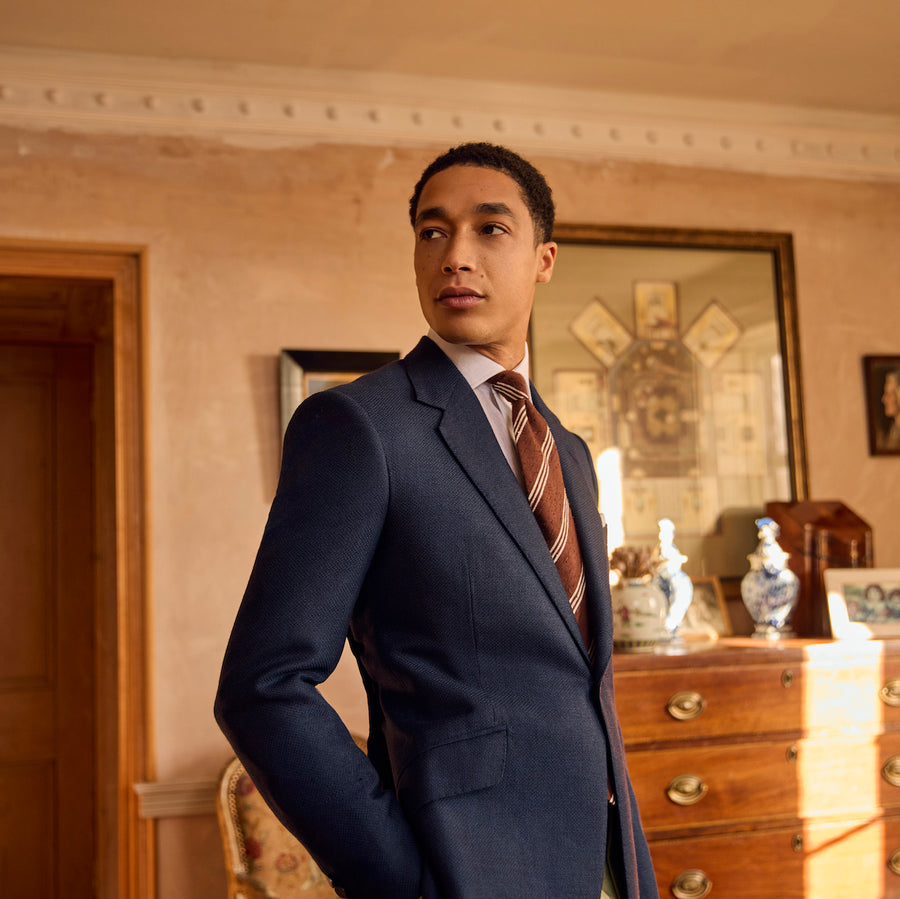His initial address was not at 11 Savile Row, our home today, but just one street adjacent at 126 New Bond Street. Huntsman, as the name suggests, was passionate about all manner of equestrian sport and country pursuits, a love he shared with his two sons, who would after that join the business as ‘Huntsman & Co’, and following his retirement ‘H. Huntsman & Sons’. In 1886, the company earned its first Royal Warrant as a Leather Breeches Maker to HRH the Prince of Wales (later Edward VII). This was swiftly followed by that of Queen Victoria’s second son, HRH Prince Albert, Duke of Saxe Coburg Gotha, in 1876 and Queen Victoria herself in 1888.



Before Huntsman grew acclaim as a bespoke tailor, we were primarily a desirable equestrian wear workshop. The secret of Huntsman’s early success? Henry realised that good riding breeches combined quality hand tailoring with some practical engineering. A design he patented as ‘The Huntsman Knikerbocker breeches’. With three royal warrants secured against the Huntsman name, the house quickly gained a reputation for dressing Europe’s hunting and riding aristocracy for much of the nineteenth century. With an influx of sartorially discerning nobility, who looked to Huntsman to furnish all of their equestrian needs, including hunt coats, tweeds and country tailoring, following the great war in 1919, Huntsman claimed a rightful place among the tailoring titans of Savile Row taking residence at number 11.
The Duke of Windsor began to favour Huntsman’s riding attire at the advent of the 1920s and soon spread the word amongst much of his social circle. In his wake, orders were received from Lord Louis Mountbatten, Viscount Churchill and Rudolph Valentino. Indeed, Huntsman became a beacon of equestrian wear for high-profile figures and the bright young things of the 1920s. Coco Chanel visited Huntsman in 1925 and ordered breeches and riding skirts for her weekends in the country. Of course, the traditional drab or brown whipcord breaches would not do for Madam Chanel. True to her iconic style, only the chicest breaches would suffice. The only colour she desired was black. And Chanel was not the only pioneering woman who favoured Huntsman equestrian wear. Take Miss Aileen Bell, a society lady from Queensland, Australia, with strong ties to the UK. In fact, Aileen served as a nurse in Europe during WWI and, in 1919, returned to Australia, where her family played host to Edward VIII, pictured here riding with Miss Bell on horseback and, later, the Queen Mother.


From an equestrian and sporting tailor to a bespoke fashion house, the patronage of stars such as Clarke Gable, Paul Newman, Katherine Hepburn and Gregory Peck transformed our reputation. The house now existed almost as two entities, one which catered to traditional country sport and riding, the other as an atelier outfitting Hollywood’s leading lights. The 1950’s also saw Huntsman appoint the fashionable formidable Collin Hammick as Head Cutter & Creative Director. Legendary for his unparalleled skill, fierce temperament and impeccable style (he was known to change his suits three times a day), Hammick recognised how Huntsman could combine our equestrian heritage and reputation to create a new house style: The One Button Cut. Every house on Savile Row has a house-style. A cut of suit that is unique to them. Huntsman’s is widely regarded as technically the most complex but flattering. Hammick took all of the best features of a classic hunt coat; the high armholes for ease of movement, the flared skirt for atop horseback and the structured shoulders for poise and elegance- and combined these with nuances of a contemporary tuxedo. A three-button fastening became one, canvasing became lighter, and the result was a jacket that naturally cinched at the waist, elongated the silhouette, was comfortable, retained its structure- and was instantly recognisable. By the end of the 1960s, it was said that one Huntsman client could recognise another in a crowded room just by the cut of his suit. By returning to our roots as an equestrian tailor, Hammick had completed the puzzle, and Huntsman then is not unfamiliar to Huntsman now.



The 1960s also saw a seismic shift of Huntsman clients from sportsmen to the spectator. Gregory Peck and David Niven both sported styles of Huntsman morning wear at Royal Ascot. Peck so favoured his Huntsman morning wear that he wore the same suit as part of his wardrobe for ‘The Omen’ in 1976! Today, Royal Ascot remains an important date in the Huntsman calendar. The 1980’s saw Huntsman grow, encorporing Henry Maxwell & Co, the bespoke bootmaker and Rowes Of Bond Street, the bespoke shirtmaker. Every bespoke requirement for your equestrian needs can now be found in one tailor, including Savile Row riding stocks, hunting shirts, riding spurs and our patented ‘Pink Coat Renovator’ cleaning cream.
Today, Huntsman’s contemporary clientele expects the finest handcrafted clothes for every occasion, ridingwear included. Visit the first-floor clubroom at 11 Savile Row, and there you’ll find where it all began- Henry Huntsman’s own riding breeches on display for all to see.










